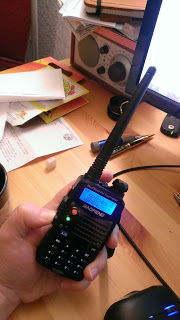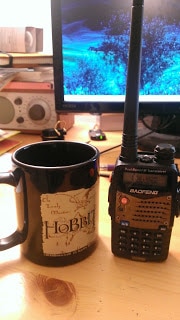Got my $44 UV-5RA Chinese built ham radio. For the price I couldn’t pass it up just to see how good a ham radio this cheap could be.
Update 2014-05-11 It has been a little over a year since I first wrote this and BaoFeng has released several versions of this radio, UV-5RE, UV-82, FB-F8+, UV-B5, GT3, UV-5R+, etc. More or less that radios are all the same so I’d stick with whichever is the cheapest. The UV-82 style is a little larger so some find it more comfortable, personally I prefer the smaller size of the UV-5RA. If you need part 90 compliance it’s a good idea to make sure the model you’re interested in is part 90 certified. See: http://www.miklor.com/COM/UV_Certification.php
Also, since my original review there are now more accessories available. Including AA and AAA battery packs.
BaoFeng Legal Operation Q&A (added 2014-05-11)
I see a lot of misinformation about what this radio can be used for legally in reviews so I want to clarify how this radio can and cannot be used in the United States.
Q. Is this a walkie-talkie? Can I just pick a random frequency to transmit on?
A. Absolutely not. You could easily be transmitting on frequencies allocated to local businesses, public services, or emergency service channels and quickly have the FCC knocking on your door with a very large fine.
Q. Can I use this on FRS (Family Radio Service) band?
A. No. The radio is capable of transmitting on these frequencies, but it isn’t legal to do so for three reasons. 1. The lowest output settings on the Baofeng exceeds the 500 milliwatt limit set by the FCC for the FRS band. 2. FRS radios must have permanently attached antennas. 3. FCC only permits radios that are part 95 certified for FRS, which the BaoFeng is not.
Q. I have a GMRS license. Can I use this on the GMRS (General Mobile Radio Service) band?
A. No. The radio is capable of transmitting here, but once again it is not legal to do so because the BaoFeng has not been part 95 certified for GMRS.
Q. Can I use the BaoFeng to transmit on MURS (Multi-Use Radio Service)/Business Band?
A. No. The radio is capable of transmitting on MURS channels, but the BaoFeng is not part 95 certified for MURS use. Some part 90 certified radios that operate on MURS were grandfathered in without having to be part 95 certified, but only for certain radios licensed before November 13, 2000.
Q. I have an amateur radio license. Can I use this on Ham radio bands?
A. Yes. If you have a valid ham radio license you can use this radio on any of the amateur radio frequencies you’re allowed to transmit on as long as you’re communicating with other licensed amateur radio operators. Just follow your normal rules for ham radio.
Q. I am on a boat. Can I transit on Marine VHF bands?
A. No. FCC requires Marine VHF radios to be part 80 certified which the BaoFeng is not.
Q. I have an FCC license to operate on certain frequencies, can I use the radio for that?
A. Yes, you’ll have to check your specific license for your business/organization but in general if your radio is part 90 certified and you have an FCC license you can use these radios.
Q. I work/am volunteering for an event with my Fire Department, Police Station, etc. Can I use the BaoFeng for that since it’s part 90 certified?
A. No. You should use whatever radio you have been issued instead of the BaoFeng. Even if they gave you permission to use your own radio (which they should not as it’s a liability for them) it’s a bad idea.
My Thoughts on Legal Frequencies for the BaoFeng
Basically you can not use these radios without an FCC license. I think the FCC rules are a little strict (you would literally have to buy four radios if you want to transmit on FRS/GMRS, MURS, Ham, and Marine bands) but the rules are the rules. The best license to get is an amateur radio license. But if you are starting a prepper group and want to issue a radio to all your members your best option is to get an FCC license. A local license will require going through a frequency coordinator, or if you can file for an itinerant license yourself, I believe this is around $160 for a 10-year license.
Anyway, on to the review…
+ Part 90 certified, this means it’s legal to transmit on part 90 frequencies (if licensed to do so) making it a great radio for dual purpose ham/business.
+ 2.5 kHz steps, most ham radios, even the very expensive rigs can only do 5 kHz.



Just wanted to give you a heads up that I was able to find AA battery packs for this radio over on ebay. No idea on quality yet, but thought I’d pass it along to you.
http://www.ebay.com/itm/BAOFENG-Battery-Case-6x-AA-BATTERY-UV-5R-UV-5RE-UV-5RB-UV-5RE-UV5R-/370822417706?pt=US_Radio_Comm_Device_Batteries_Chargers&hash=item5656bd0d2a
Thanks, I have the UV-5RA (slightly different design) so it won’t work with mine…
DOH! Missed that. Check this one out, then. :) It’s AAA’s, but better than nothing.
http://www.happyhamshop.com/baofeng-uv5r-aaa-battery-case-p-1300.html
That looks like it would work. Thanks!
BAOFENG UV-5RA Dual Band VHF UHF can listen to the air band?
pl
No, it can only use fm mode.
My UV5ra does 220 !
Cool, can it actually transmit on that band?
dear dr ben, I’ve looked through your post three times now!& no where do u state how to modify the radio for 6mtr! your post only mentions getting a better battery pack! since it’s my intention to use this on a ‘base’ samlex power supply! I’m planning on getting the 12vdc battery by pass pack! so please, what do I clip??
Hi, Thomas. The UV-5RA can’t be modified for 6-meter. Thanks, Ben
http://detail.tmall.com/item.htm?spm=a230r.1.14.1.OzPzoX&id=36561216483&ad_id=&am_id=&cm_id=140105335569ed55e27b&pm_id= very cheap
Great review! I was just wondering for the no-transmit workaround, you said, In “channel mode” you can disable transmit on specific channels, so I programmed all the frequencies I don’t ever want to transmit (e.g. Police) with transmit disabled.” Were you able to do this manually through the radio itself or through the software?
Thanks Justin. I did this through software–with Chirp. I believe the latest versions of Chirp have a transmit off option for each channel which programs in the impossible offset for you. I believe you can do it on the radio directly but I haven’t tried.